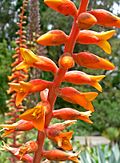Classification System: APG IV
Superregnum: Eukaryota
Regnum: Plantae
Cladus: Angiosperms
Cladus: Monocots
Cladus: Commelinids
Ordo: Poales
Familia: Bromeliaceae
Subfamilia: Pitcairnioideae
Genera: Deuterocohnia – Dyckia – Encholirium – Fosterella – Pitcairnia
Name
Pitcairnioideae Harms ex Engler, H.G.A. & Prantl, K.A.E. (1930). Nat. Pflanzenfam., ed. 2, 15a: 99.
Type genus: Pitcairnia L’Hér., (1789) nom. cons.
References
Harms, H. in Engler, H.G.A. & Prantl, K.A.E. 1930. Nat. Pflanzenfam., ed. 2, 15a: 99.
Givnish, T.J., Millam, K.C., Berry, P. E. & Sytsma, K. J. 2007. Phylogeny, adaptive radiation, and historical biogeography of Bromeliaceae inferred from ndhF sequence data. Aliso 23(1): 3–26. DOI: 10.5642/aliso.20072301.04 PDF Reference page.
Links
The Family Bromeliaceae at APWebsite.
The Bromeliad Society International.
Derek Butcher: Key to the genera of Bromeliaceae.
The Pitcairnioideae comprise the terrestrial subfamily of the bromeliads (Bromeliaceae) with over 1000 species in 16 genera. Unlike the many epiphytes and lithophytes which make up the rest of the family, with a few exceptions, all of the members of this subfamily are either terrestrial or saxicolous. Common to arid and high-altitude regions, this subfamily is considered to have the most ancient lineage, more closely resembling its grassy relatives than the exotic novelties represented in the other two subfamilies. The commonly cultivated genera from this group include Dyckia, Hechtia, Pitcairnia, and Puya.
Description
Most Pitcairnioideae leaves are fleshy with heavy spines on the edges, and resemble agave. Their blooms contain dry capsules with small, wingless seeds. Like most plants, and unlike most other bromeliads, this group has a developed root system to gather water and nutrients. Similarly, not all pitcairnioid leaves grow in an effective cup to catch water as is seen in the other families. Leaf trichomes are present in the Pitcairnioideae, but are not effective in gathering nutrients; the trichomes, however, can be sufficiently thick so as to provide a frost barrier essential to its survival (e.g. Puya laxa).
Genera
The 16 genera are:
| Image | Genus | Number of living species |
|---|---|---|
| Brewcaria L.B.Sm., Steyerm. & H.Rob. | 6 | |
 |
Brocchinia Schult.f. ex Schult. & Schult.f. | 20 |
 |
Connellia N.E.Br. | 6 |
| Cottendorfia Schult.f. | 1 | |
 |
Deuterocohnia Mez | 18 |
 |
Dyckia Schult.f. | 130 |
 |
Encholirium Schult.f. | 22 |
 |
Fosterella L.B.Sm. | 30 |
 |
Hechtia Klotzsch | 52 |
| Lindmania | 38 | |
| Navia | 93 | |
 |
Pepinia Brongn. ex André | 57 |
 |
Pitcairnia L'Hér. | 331 |
 |
Puya Molina | 219 |
| Sequencia (L.B.Sm.) Givnish | 1 | |
| Steyerbromelia L.B.Sm. | 6 |
References
http://www.ecocam.com/species/Bromeliaceae.html
http://www.ucmp.berkeley.edu/monocots/bromeliflorae.html
BSI - Bromeliad Info - Taxonomy
LUTHER, H. E. (2008) An Alphabetical List of Bromeliad Binomials, Eleventh Edition The Marie Selby Botanical Gardens, Sarasota, Florida, USA. Published by The Bromeliad Society International.
Retrieved from "http://en.wikipedia.org/"
All text is available under the terms of the GNU Free Documentation License

